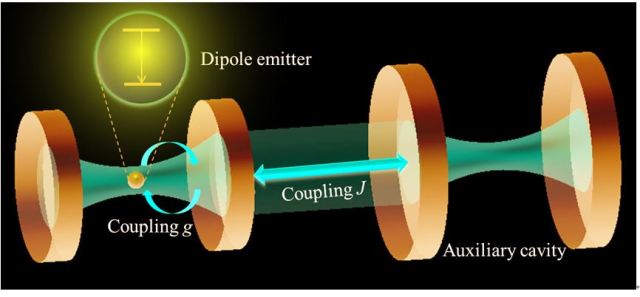Jun 11 2014
Coherent light-matter interaction at the single photon level is a long-standing goal for quantum operations. To reach such strong coupling regime, previous studies mainly focus on improving the quality (Q) factor and reducing the mode volume (V) of the same optical resonators, but they have already reached their limits due to current fabrication and other technological restrictions.
 Fig. 1. Schematic of the cavity QED system coupled to an auxiliary cavity.
Fig. 1. Schematic of the cavity QED system coupled to an auxiliary cavity.
Very recently, a team led by Professors Xiao Yun-Feng and Gong Qihuang at Peking University, collaborated with Columbia University, have demonstrated the strong coupling via dark state resonances in a coupled-cavity quantum electrodynamics system, by removing the requirement for high Q and small V in the same cavity [Phys. Rev. Lett. 112, 213602 (2014)]. Strong coupling has been demonstrated in a highly dissipative cavity even with the decay rate in excess of the interaction strength by two orders of magnitude.
“For coherent manipulation in cavity quantum electrodynamics (QED), a key prerequisite is to reach the strong coupling regime, where the emitter-field coupling strength exceeds the decay rates of the emitter and the cavity field,” said Xiao, the leading scientist of the team.
In the past two decades great efforts have been made to improve the quality (Q) factor and reduce the mode volume (V) of the same resonators for stronger interactions. However, it remains difficult to achieve high Q and small V simultaneously for the same-type resonator. Fundamentally, this is related to the diffraction limit. A smaller V corresponds to a larger radiative decay rate and more significant roughness scattering, leading to a lower Q.
Unlike the efforts to improve the Q/V figure of merit of the cavities, the team proposes reaching the strong coupling regime via dark state resonances, which removes the requirement for high Q and small V for the same cavity. By coupling the originally weak-coupled cavity QED system with high cavity dissipation to an auxiliary cavity mode with high Q but large V, a strong dark state interaction takes place. They demonstrate that vacuum Rabi oscillations and anharmonicity in the polariton dressed states occur even when the cavity decay rate is 2 orders of magnitude larger than the interaction rate.
“This provides a promising platform for overcoming decoherence in quantum operations and advancing the coherent manipulation of polariton qubits,” said Xiao.
Edited by: Zhang Jiang
Source: School of Physics